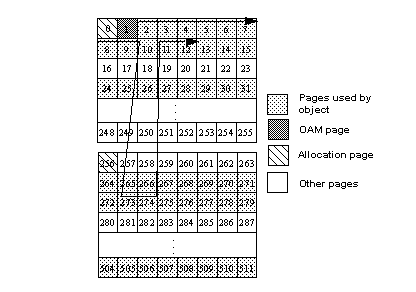Adaptive Server page allocation mechanism strives to keep pages that belong to the same object close to each other in physical storage by allocating new pages on an extent already allocated to the object and by allocating new extents on allocation units already used by the object.
However, as pages are allocated and deallocated, page chains on data-only-locked tables can develop kinks. Figure 6-1 shows an example of a kinked page chain between extents in two allocation units.
Figure 6-1: A kink in a page chain crossing allocation units

In Figure 6-1, when a scan first needs to access a page from allocation unit 0, it checks the allocation page and issues asynchronous I/Os for all the pages used by the object it is scanning, up to the limit set on the pool. As the pages become available in cache, the query processes them in order by following the page chain. When the scan reaches page 10, the next page in the page chain, page 273, belongs to allocation unit 256.
When page 273 is needed, allocation page 256 is checked, and asynchronous prefetch requests are issued for all the pages in that allocation unit that belong to the object.
When the page chain points back to a page in allocation unit 0, there are two possibilities:
The prefetched pages from allocation unit 0 are still in cache, and the query continues processing with no unneeded physical I/Os.
The prefetch pages from allocation unit 0 have been flushed from the cache by the reads from allocation unit 256 and other I/Os taking place by other queries that use the pool. The query must reissue the prefetch requests. This condition is detected in two ways:
Adaptive Server’s count of the hops between allocation pages now equals two. Adaptive Server uses the ratio between the count of hops and the prefetched pages to reduce the size of the look-ahead set, so fewer I/Os are issued.
The count of prefetched but unused pages in the pool is likely to be high, so asynchronous prefetch may be temporarily discontinued or reduced, based on the pool’s limit.